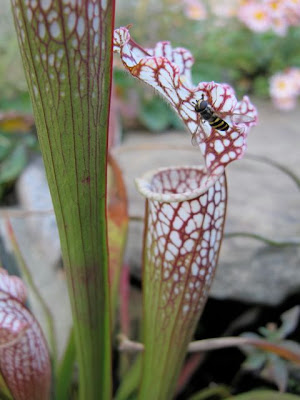It is humbling to have, growing vigorously in my backyard pond (and now on the floor of my greenhouse), a plant that is so terribly rare in the wild, so over-exploited and endangered, that its very existence in the wild is in question. Native to low-nutrient longleaf pine savannas along the Gulf Coast (generally along the Florida panhandle), Sarracenia alba is one of the showiest and most beautiful of the pitcher plants.
S. alba, being so showy, is vulnerable to collection and the despicable exploitation by florists, whereby flowercutters will denude entire stands of all their pitchers to get the long-lasting specialized leaves for arrangements. Inexcusable. Never buy an arrangement with pitchers in it. Worse yet is habitat loss from wetland draining and development. Fire suppression also knocks back populations when they get shaded out by overgrowth. Yes, the white pitcher plant is getting it from all sides in the wild, even though it's easy to propagate in captivity.
I came by this plant from fellow blogger and plant maven Cheryl Harner, author of the wonderful Weedpicker's Journal, who gave it and a red variant to me years ago. She told me it's best grown in distilled water, and warned that my fishpond would probably have too many nutrients for this entirely carnivorous plant. The way it works is that the plant takes all its nutrients from the bodies of insects it traps and digests, and it can't take nutrition through its roots. The pitchers are lined with slick, stiff, downward pointing hairs, and any insect that topples into the specialized leaf is not getting back out. Period. It falls in with the others being rapidly digested by the sweet-smelling fluids at the bottom of the pitcher. Eeek!
I looked at the plants a little dubiously. With all I have to care for here, did I really want plants I'd have to coddle along in containers of distilled water? And while I thought about how to best provide for it, into the fishpond it went. And in the fishpond it stayed, through summer and winter, and it didn't do a whole lot, put up some little bitty pitchers here and there, and a bunch of long narrow leaves that never became pitchers. It was a little disappointing, but I only had myself to blame. Still wasn't really into the distilled water thing.
This spring, while cleaning the pond, I looked at that nice little plant and thought, "You've lived through all these winters, the snow and ice, and you've always come back, but you could be so much more." So I took the plant out of its pot and swaddled its paltry roots tightly in dried sphagnum moss because I thought it would like the acidity. I put it in a bigger clay pot and sank it in the pond.
And it did this:
Said thank you thank you thank you, it did, with a flush of the finest two-foot-tall fall pitchers I'd ever seen!
So I'm photographing it on a fine late October afternoon and I happen to lift a lid to see what's going on in there and YIKES the entire flute is stuffed with hapless insects!
Maybe hundreds. Here's a side view. Something has bitten into the flute and you can see black. That's the bodies of insects. They go all the way up to where the red and white markings start on each flute.
In my next post, I do a typically Zicklike thing about it all.










4 comments:
What a great post! We have been growing carnivorous plants as a hobby for many years and they provide endless opportunities of excitement and curiosity. Beautiful plant!
Don't miss Liam's little socky feet in the insect discovery photo. He had to come see why I was hollerin'!
I'm eagerly awaiting a lesson in pitcher plant forensics.
Any idea where to get seeds or live plants of this particular species? I would love to add this to my garden!
Post a Comment